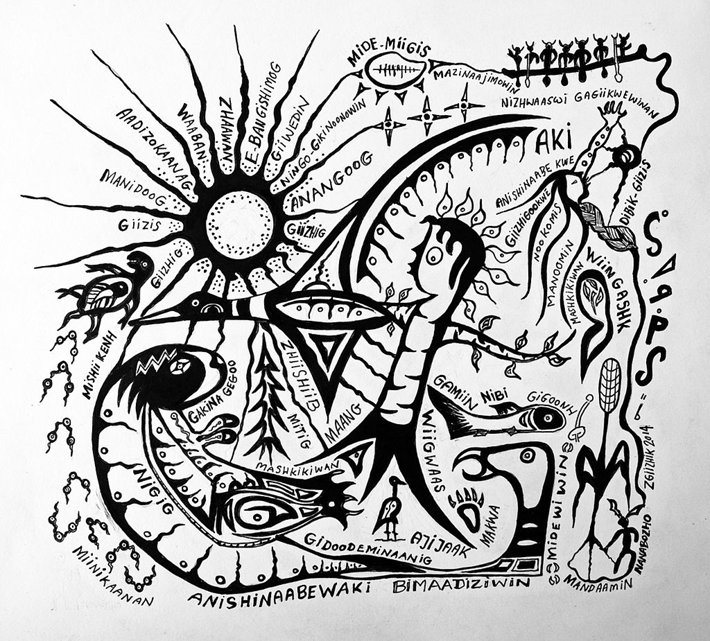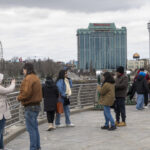Chief Shingwaukonse was displeased with the situation he saw unfolding before him.
His people, the Anishinaabe, were being usurped, deprived of mino-bimaadiziwin—the way of the good life—by miners eager to exploit the rich copper deposits on their lands on the Canadian side of Lake Superior. The colonial government was granting mining licenses indiscriminately in the name of the British Crown, even though the land was not under the Crown’s jurisdiction.
In the year 1848, the vast area marked UNSURRENDERED on current maps had never been relinquished to anyone and still belonged to the Indigenous peoples who had inhabited it for generations.
However, Chief Shingwaukonse observed that the wildlife was disappearing—and his people relied on them for sustenance, clothing, and various other necessities. Furthermore, the settlers were setting fires in the forests, accelerating the erosion of their way of life. Shingwaukonse knew that his people would not stand idly by and watch as their culture, traditions, and identity were taken away. His intuition proved correct.
The following year, a group of Indigenous individuals took over and occupied a copper mine. Troops were called in, and long overdue negotiations commenced.
Representing Queen Victoria, William Benjamin Robinson negotiated two treaties with the Anishinaabe, in which they “fully, freely and voluntarily” agreed to cede their territory to Queen Victoria and her successors. In return, they retained hunting and fishing rights, and the Crown would provide them with a perpetual annuity, albeit a modest one.
However, the treaties held the promise of more. One crucial clause stipulated that if the land generated enough revenue in the future to enable the government to increase the annuity without incurring losses, then it must be raised “from time to time.”
The annuity was only increased once, in 1875, following Indigenous protests. It has remained at 4 Canadian dollars per person, approximately $3 U.S., ever since.
Over the next 150 years, while the treaties were largely forgotten, the former British colony of Canada reaped immense benefits from the fertile lands north of the Great Lakes, while the First Nation peoples suffered.
These broken treaties became the focal point of a significant lawsuit that began in the 1990s and has recently been concluded.
Raymond Goodchild, who grew up in a humble dwelling and slept on a discarded mattress, testified in an Ontario court that the British Crown’s unfulfilled promises had left Indigenous individuals like himself in poverty.
He resided near the prosperous town of Thunder Bay, filled with paved streets and elegant houses with manicured lawns.
“My God almighty … I still envy those people that had those houses,” Goodchild, a 67-year-old Canadian Armed Forces veteran, testified in Sudbury, Ontario last year. He would pass by them and think, “Wow, what a world—a completely different world from where I came from.”
In 2018, Ontario Superior Court Justice Patricia Hennessy declared that the commitments of the Robinson treaties had been “completely forgotten” by the Crown, and that the court had the “authority and the imperative” to impose obligations on it. The ruling was appealed, with the appeals court largely upholding it.
Given the potential precedent it could set for future cases involving compensation for First Nation tribes, the case garnered significant attention.
At this juncture, there is no dispute on either side that the Indigenous people were dealt an unfair hand. In November, the province of Ontario acknowledged that it had failed to uphold its promise to Chief Shingwaukonse and his people. The remaining issue at hand: the settlement amount.
The government, as expected, prefers a lower figure: $1.8 billion, contending that it has no legal obligation to provide any compensation, partly due to the billions of dollars it has already invested in infrastructure and development over the years. Additionally, the government argued that financial restitution is not within a judge’s purview.
The First Nations groups disagreed. “After 173 years of government neglect and inattention, it is only fair and just for the chickens to come home to roost,” their cocounsel Harley Schachter countered.
Another cocounsel, Kaitlyn Lewis, added that the agreement “wasn’t sort of living in squalor” while settlers lived “lives of plenty.”
The plaintiffs presented their own calculation, based on an economic model devised by Nobel Prize-winning economist Joseph Stiglitz: $90 billion. “If you’ve owed somebody something year after year after year for 170 years, it’s a lot of money,” he remarked.
As a child, Wilfred King, chief of Gull Bay First Nation, heard the elders discuss the Robinson treaties. It wasn’t until he was older that he comprehended their significance and the long-lasting devastation they had caused.
“We’ve been kept in abject poverty,” he lamented. “Our people are living in a very, very dire situation. Those treaties, had they been implemented initially, First Nations would have probably been in a much better position than they are today.”
Patricia Tangie, chief of the Michipicoten First Nation, who witnesses resources being extracted from her lands while her people endure poverty, substandard housing, lack of paved roads, and limited access to medical care, expressed her disillusionment with the lengthy legal battle, believing that “Canada has no commitment to reconciliation.”
Then, on January 3, action was taken. All parties signed the settlement: $10 billion. The settlement is now finalized, and the First Nation signatories of the original 19th-century treaty should begin receiving the long-delayed funds as early as this spring.
Though long overdue, the settlement will provide a measure of justice to many individuals, both living and deceased.
Through this resolution, a profound spiritual connection linking the past, present, and future may offer Chief Shingwaukonse—the Midewiwin who continues to watch over his people—a sense of peace at last.
_________________
From its inception, the Church of Scientology has acknowledged the fundamental human right of freedom of religion. In a world where conflicts often arise from intolerance towards others’ religious beliefs and practices, the Church has prioritized the preservation of religious liberty for over five decades.
This blog is published by the Church to promote a better understanding of religious freedom and provide updates on issues affecting this freedom worldwide.
The Founder of the Scientology religion is L. Ron Hubbard and Mr. David Miscavige serves as the religion’s ecclesiastical leader.
For more information, visit the Scientology website or Scientology Network.





